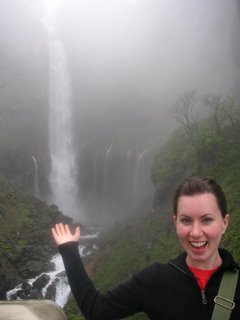 Lake Chuzenji
Lake Chuzenji Priest Shoto, who popularized mountainous worship in Nikko, found the Lake Chuzenji in 782 when he climbed Mt. Nantai. Two years later, he and his followers built Jinguji Temple lakeside. Since then, ascetics visited and Funazenjou was taken place.
Priest Shoto, who popularized mountainous worship in Nikko, found the Lake Chuzenji in 782 when he climbed Mt. Nantai. Two years later, he and his followers built Jinguji Temple lakeside. Since then, ascetics visited and Funazenjou was taken place.  The Funazenjou is an event that ascetics visit holy place lakeside by boat with reading sutra out. In the medieval age and early modern times, more ascetics came to Nikko, and they prayed a lot for miracle.
The Funazenjou is an event that ascetics visit holy place lakeside by boat with reading sutra out. In the medieval age and early modern times, more ascetics came to Nikko, and they prayed a lot for miracle. 
However, Nikko lost its religious fever when Hideyoshi Toyotomi confiscated the mountainous area of Nikko. Nonetheless, Nikko was activated again by Bishop Tenkai's arrival, and after reconstruction of Toshogu Shrine. Construction of tea-house was permitted for ascetics' use in 1741, and 6 tea-houses were built lakeside in 1804. People lived there from spring to fall, but they climbed down the mountain in winter.
A remarkable turning point came in 1872, when women were allowed to go inside the mountainous area. They climbed Mt. Nantai and the first delivery in that area was recorded in 1884. Also, Meiji Emperor came to Nikko and named "Lake of happiness" for the Lake Chuzenji.
 Although, number of visitor made a rapid progress, foreigners built the basis. Diplomats from Western countries came to Nikko to pass the summer, and they built cottage lakeside. You will still find some cottages of foreign embassies such as France, Belgium, and two other nations. International celebrities were listed on the membership of Tokyo Angling and Country Club. The outskirts of Lake Chuzenji established its status as a resort in which a high-class person gathers.
Although, number of visitor made a rapid progress, foreigners built the basis. Diplomats from Western countries came to Nikko to pass the summer, and they built cottage lakeside. You will still find some cottages of foreign embassies such as France, Belgium, and two other nations. International celebrities were listed on the membership of Tokyo Angling and Country Club. The outskirts of Lake Chuzenji established its status as a resort in which a high-class person gathers.  Just some random fun shots!!!
Just some random fun shots!!!



There are 48 waterfalls in Nikko, but Kegon waterfall is the most famous among these. The water falls from 97 meters high and you will enjoy natural beauty around the fall. Nachi waterfall in Wakayama prefecture, Fukuroda waterfall in Ibaragi prefecture and Kegon waterfall in Nikko are known as the finest three waterfalls of Japan.

The name of the Kegon was derived from a part of Buddhist sutra. By the way, names of Nehan waterfall and Hannya waterfall also were derived from the Buddhist sutra.
People could not get close to the fall until 1900 when Gorobei Hoshino built a tea-house near the basin of the fall. It took him 7 years to build. Also, Kegon waterfall became a noted place of suicide when 18 years old high school student, Misao Fujimura jumped into the fall in May 1903.

0 件のコメント:
コメントを投稿